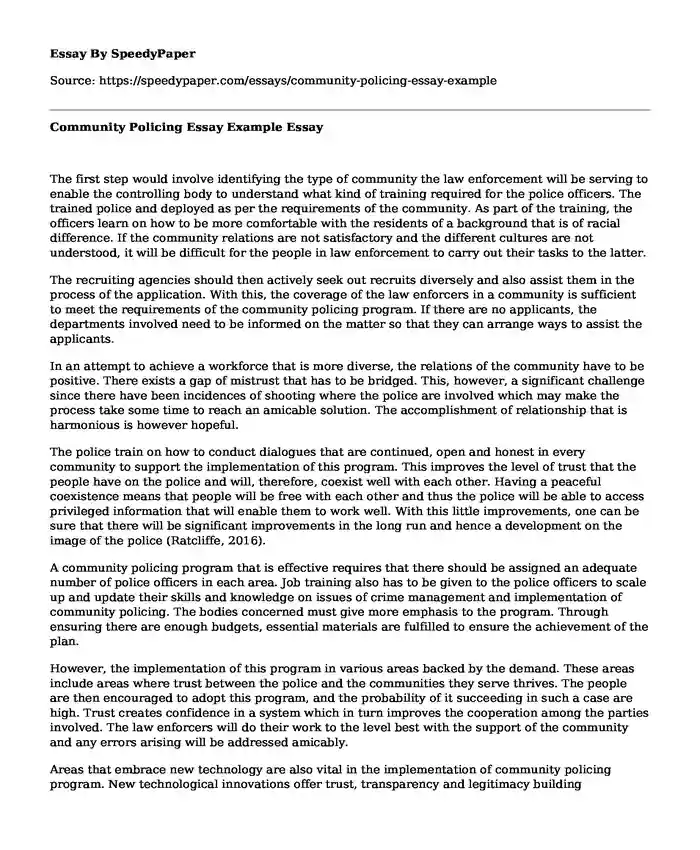The first step would involve identifying the type of community the law enforcement will be serving to enable the controlling body to understand what kind of training required for the police officers. The trained police and deployed as per the requirements of the community. As part of the training, the officers learn on how to be more comfortable with the residents of a background that is of racial difference. If the community relations are not satisfactory and the different cultures are not understood, it will be difficult for the people in law enforcement to carry out their tasks to the latter.
The recruiting agencies should then actively seek out recruits diversely and also assist them in the process of the application. With this, the coverage of the law enforcers in a community is sufficient to meet the requirements of the community policing program. If there are no applicants, the departments involved need to be informed on the matter so that they can arrange ways to assist the applicants.
In an attempt to achieve a workforce that is more diverse, the relations of the community have to be positive. There exists a gap of mistrust that has to be bridged. This, however, a significant challenge since there have been incidences of shooting where the police are involved which may make the process take some time to reach an amicable solution. The accomplishment of relationship that is harmonious is however hopeful.
The police train on how to conduct dialogues that are continued, open and honest in every community to support the implementation of this program. This improves the level of trust that the people have on the police and will, therefore, coexist well with each other. Having a peaceful coexistence means that people will be free with each other and thus the police will be able to access privileged information that will enable them to work well. With this little improvements, one can be sure that there will be significant improvements in the long run and hence a development on the image of the police (Ratcliffe, 2016).
A community policing program that is effective requires that there should be assigned an adequate number of police officers in each area. Job training also has to be given to the police officers to scale up and update their skills and knowledge on issues of crime management and implementation of community policing. The bodies concerned must give more emphasis to the program. Through ensuring there are enough budgets, essential materials are fulfilled to ensure the achievement of the plan.
However, the implementation of this program in various areas backed by the demand. These areas include areas where trust between the police and the communities they serve thrives. The people are then encouraged to adopt this program, and the probability of it succeeding in such a case are high. Trust creates confidence in a system which in turn improves the cooperation among the parties involved. The law enforcers will do their work to the level best with the support of the community and any errors arising will be addressed amicably.
Areas that embrace new technology are also vital in the implementation of community policing program. New technological innovations offer trust, transparency and legitimacy building opportunities. These innovations provide an opportunity for the people to build up the trust which gives an opportunity for the program to prevail. With the help of the technology, new frameworks that are clearly defined can be developed to assist in the process of community policing (Posavac, 2015).
Additionally, the program has also been implemented successfully in communities where the leaders have invested highly in training of the law enforcement officers. The exercises given should focus on the core values of the community to facilitate the assimilation of the program. Problem-solving skills and de-escalation are key practices oriented to the law enforcement officers guided by the availability of policing resources.
This program may not be successful in all areas. There are areas where it thrives more than in other areas due to some conditions which favour it. Community policing may fail in areas where no maximum attention prevails. A policy that is in the process of implementation needs to be monitored every step to ensure that it serves the desired function. Complete follow up is also required to provide that the implementation of the program is complete and stable.
In conclusion, this program could also fail where there is no mobilization of society towards crime prevention and building of peace and even where it is a one-time activity. For such a program to prevail, mobilization has to be done frequently and in a manner that is timely. Victims of crime may live in fear of more attacks and tend not to trust people as they fear the same situation could arise. In this case, community policing would come to the aid of such people and help them in leading healthy lives again.
References
Cordner, G. (2014). Community policing. The Oxford handbook of police and policing, 148-171.
Posavac, E. J. (2015). Program evaluation: Methods and case studies. Routledge.
Ratcliffe, J. H. (2016). Intelligence-led policing. Routledge.
Cite this page
Community Policing Essay Example. (2022, Aug 26). Retrieved from https://speedypaper.com/essays/community-policing-essay-example
Request Removal
If you are the original author of this essay and no longer wish to have it published on the SpeedyPaper website, please click below to request its removal:
- Essay Sample: Playing World of Warcraft vs Content and Language Integrated Learning
- GLYCEMIA IN A KUWAITI POPULATION
- What Is Gender Role Essay Sample
- Critical Thinking Research Sample
- Literary Essay Sample: The Necklace Story Research
- Free Essay: Why Drugs Shouldn't Be Legal
- Free Essay Example - Head Lice
Popular categories





